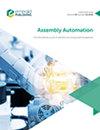Torque vectoring control system for distributed drive electric bus under complicated driving conditions
IF 1.7
4区 计算机科学
Q3 AUTOMATION & CONTROL SYSTEMS
引用次数: 1
Abstract
Purpose The purpose of this study is to propose a torque vectoring control system for improving the handling stability of distributed drive electric buses under complicated driving conditions. Energy crisis and environment pollution are two key pressing issues faced by mankind. Pure electric buses are recognized as the effective method to solve the problems. Distributed drive electric buses (DDEBs) as an emerging mode of pure electric buses are attracting intense research interests around the world. Compared with the central driven electric buses, DDEB is able to control the driving and braking torque of each wheel individually and accurately to significantly enhance the handling stability. Therefore, the torque vectoring control (TVC) system is proposed to allocate the driving torque among four wheels reasonably to improve the handling stability of DDEBs. Design/methodology/approach The proposed TVC system is designed based on hierarchical control. The upper layer is direct yaw moment controller based on feedforward and feedback control. The feedforward control algorithm is designed to calculate the desired steady-state yaw moment based on the steering wheel angle and the longitudinal velocity. The feedback control is anti-windup sliding mode control algorithm, which takes the errors between actual and reference yaw rate as the control variables. The lower layer is torque allocation controller, including economical torque allocation control algorithm and optimal torque allocation control algorithm. Findings The steady static circular test has been carried out to demonstrate the effectiveness and control effort of the proposed TVC system. Compared with the field experiment results of tested bus with TVC system and without TVC system, the slip angle of tested bus with TVC system is much less than without TVC. And the actual yaw rate of tested bus with TVC system is able to track the reference yaw rate completely. The experiment results demonstrate that the TVC system has a remarkable performance in the real practice and improve the handling stability effectively. Originality/value In view of the large load transfer, the strong coupling characteristics of tire , the suspension and the steering system during coach corning, the vehicle reference steering characteristics is defined considering vehicle nonlinear characteristics and the feedforward term of torque vectoring control at different steering angles and speeds is designed. Meanwhile, in order to improve the robustness of controller, an anti-integral saturation sliding mode variable structure control algorithm is proposed as the feedback term of torque vectoring control.复杂工况下分布式驱动电动客车转矩矢量控制系统
目的提出一种转矩矢量控制系统,以提高分布式驱动电动客车在复杂驾驶条件下的操纵稳定性。能源危机和环境污染是人类面临的两大紧迫问题。纯电动公交车被认为是解决这些问题的有效方法。分布式驱动电动客车(DDEB)作为一种新兴的纯电动客车模式,正吸引着世界各地的研究兴趣。与中央驱动的电动公交车相比,DDEB能够单独准确地控制每个车轮的驱动和制动扭矩,显著提高操控稳定性。因此,提出了扭矩矢量控制(TVC)系统来合理分配四个车轮之间的驱动扭矩,以提高DDEB的操纵稳定性。设计/方法论/方法所提出的TVC系统是基于分层控制设计的。上层是基于前馈和反馈控制的直接横摆力矩控制器。前馈控制算法设计用于根据方向盘角度和纵向速度计算所需的稳态横摆力矩。反馈控制是一种以实际横摆角速度和参考横摆角速率之间的误差为控制变量的反饱和滑模控制算法。下层是转矩分配控制器,包括经济转矩分配控制算法和最优转矩分配控制方法。通过稳态循环试验验证了所提出的TVC系统的有效性和控制效果。与有TVC系统和无TVC系统的试验母线的现场试验结果相比,有TVC的试验母线滑移角比无TVC的小得多。采用TVC系统测试的客车实际横摆角速度能够完全跟踪基准横摆角速率。实验结果表明,TVC系统在实际应用中具有显著的性能,有效地提高了操纵稳定性。独创性/价值针对客车转弯过程中载荷传递大、轮胎、悬架和转向系统耦合性强的特点,考虑车辆非线性特性,定义了车辆参考转向特性,设计了不同转向角和速度下扭矩矢量控制的前馈项。同时,为了提高控制器的鲁棒性,提出了一种反积分饱和滑模变结构控制算法作为转矩矢量控制的反馈项。
本文章由计算机程序翻译,如有差异,请以英文原文为准。
求助全文
约1分钟内获得全文
求助全文
来源期刊

Assembly Automation
工程技术-工程:制造
CiteScore
4.30
自引率
14.30%
发文量
51
审稿时长
3.3 months
期刊介绍:
Assembly Automation publishes peer reviewed research articles, technology reviews and specially commissioned case studies. Each issue includes high quality content covering all aspects of assembly technology and automation, and reflecting the most interesting and strategically important research and development activities from around the world. Because of this, readers can stay at the very forefront of industry developments.
All research articles undergo rigorous double-blind peer review, and the journal’s policy of not publishing work that has only been tested in simulation means that only the very best and most practical research articles are included. This ensures that the material that is published has real relevance and value for commercial manufacturing and research organizations.
 求助内容:
求助内容: 应助结果提醒方式:
应助结果提醒方式:


